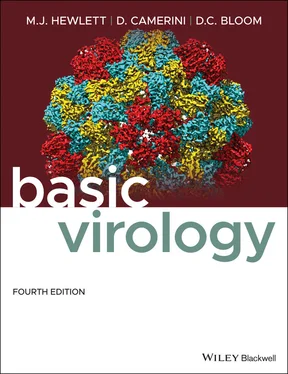Following entry, many types of viruses must move or be moved through the host to establish infection at a preferred site, the infection of which results in disease symptoms. This site, often referred to as the target tissueor target organ, is often (but not always) important in mediating the symptoms of disease, or the spread, or both.
There are several modes of virus spread in the host. Perhaps the most frequent mode utilized by viruses is through the circulatory system ( viremia). A number of viruses can spread in the bloodstream either passively as free virus or adsorbed to the surface of cells that they do not infect, such as red blood cells. Direct entry of virus into the lymphatic circulatory system also can lead to viremia. Some viruses that replicate in the gut (such as poliovirus) can directly enter the lymphatic system via Peyer's patches (gut‐associated lymphoid tissue)in the intestinal mucosa. Such patches of lymphoid tissue provide a route directly to lymphocytes without passage through the bloodstream. This provides a mode of generating an immune response to a localized infection. For example, poliovirus generally replicates in the intestinal mucosa and remains localized there until eliminated; the entry of virus into the lymphatic system via Peyer's patches leads to immunity. Virus invasion of gut‐associated lymphoid tissue is thought to be one important route of entry for HIV spread by anal intercourse, as infectious virus can be isolated from seminal fluid of infected males.
Infection of lymphoid cells can also be a factor in the spread of infectious virus. HIV infects and replicates in T lymphocytesand macrophages, leading to the generation of active carrier cells that migrate to lymph nodes. This facilitates spread of the virus throughout the immune system. Many other viruses infect and replicate in one or another cells of the lymphatic system. Some of the viruses known to infect one or another of the three major cells found in lymphatic circulation are shown in Table 2.1.
While spread via the circulatory system is quite common, it is not the only mode of general dissemination of viruses from their site of entry and initial replication in animals. The nervous system provides the other major route of spread. Some neurotropic viruses, such as HSV and rabies virus, can spread from the peripheral nervous system directly into the central nervous system ( CNS). In the case of HSV, this is a common result of infection in laboratory mice; however, it is a relatively rare occurrence in humans, and is often correlated with an impairment or lack of normal development of the host's immune system. Thus, an initial acute infection of an infant at the time of birth or soon thereafter can lead to HSV encephalitis with high frequency.
Table 2.1Some viruses that replicate in cells of the immune system.
| Cells Infected |
Virus |
| B lymphocytes |
Epstein–Barr virus (herpesvirus) |
| Some retroviruses |
| T lymphocytes |
Human T‐cell leukemia virus |
| HIV |
| Human herpesvirus 6 |
| Human herpesvirus 7 |
| Monocytes |
Measles virus |
| Varicella‐zoster virus (herpesvirus) |
| HIV |
| Parainfluenza virus |
| Influenza virus |
| Rubella (German measles) virus |
| Cytomegalovirus (herpesvirus) |
Multiplication of virus to high levels – occurrence of disease symptoms
Viral replication at specific target tissues often defines symptomsof the disease. The nature of the target and the host response are of primary importance in establishing symptoms. The ability of a virus to replicate in a specific target tissue results from specific interactions between viral and cellular proteins. In other words, one or another viral protein can recognize specific molecular features that define those cells or tissues favored for virus replication. These virus‐encoded proteins, thus, have a major role in specifying the virus's tissue tropism. Host factors, such as speed of immune response and inflammation, also play a major role. For example, a head cold results from infection and inflammation of the nasopharynx. Alternatively, liver malfunction due to inflammatory disease ( hepatitis ) could result from a viral infection in this critical organ.
One major factor in viral tropism is the distribution and occurrence of specific viral receptors on cells in the target tissue. The role of such receptors in the infection process is described in Part II, Chapter 6. For the purposes of the present discussion, it is enough to understand that there must be a specific and spatially close interaction between proteins at the surface of the virus and the surface of the cell's plasma membrane for the virus to be able to begin the infection process.
One example of the role of receptors in tissue tropism involves the poliovirus receptor, which is found on cells of the intestinal mucosa and in lymphatic tissue. A related molecule is also present on the surface of motor neurons, which means that neurotropic strains of poliovirus can invade, replicate in, and destroy these cells under certain conditions of infection. In another example, HIV readily infects T lymphocytes by recognizing the CD4 surface protein in association with a specific chemokinereceptor that serves as a coreceptor. Rabies virus's ability to remain associated with nervous tissue probably is related to its use of the acetylcholine receptor present at nerve cell synapses. The ability of vaccinia virus (like the related smallpox virus) to replicate in epidermal cells is the result of its use of the epidermal growth factor receptor on such cells as its own receptor for attachment.
While tissue tropism is often understandable in terms of a specific viral receptor being present on the surface of susceptible cells, the story can be quite complicated in practice. This is the case for Epstein–Barr virus ( EBV ), which is found in B lymphocytesin patients who have been infected with the virus. It is thought that primary infection of epithelial cells in the mucosa of the nasopharynx, followed by association with lymphocytes during development of the immune response, leads to infection of B cells that carry the EBV‐specific receptor, CD21.
Even though the infection of target tissue is usually associated with the occurrence of symptoms of that viral infection, the target is not always connected with the spread of a virus subsequent to infection. For example, HIV infection can be readily spread from an infected individual long before any clinical symptoms of the disease (AIDS) are apparent. An individual can undergo a subclinical reactivation episode where there is virus in the saliva, but no fever blister can transmit HSV. Finally, paralytic polio is the result of a “dead‐end” infection of motor neurons, and the resulting death of those neurons and paralysis have nothing to do with spread of the virus.
Later stages of infection – changes in the cell
Eventually, viral infection leads to distinct changes within the infected cell. Such alterations are termed cytopathology. These effects can most easily be observed in viral infected cells in culture. Viral‐induced changes might be found in both the cytoplasm and the nucleus, depending, of course, on the virus in question. Table 2.2lists some examples of such cytopathic outcomes of infection.
The later stages of infection – the immune response
Читать дальше












